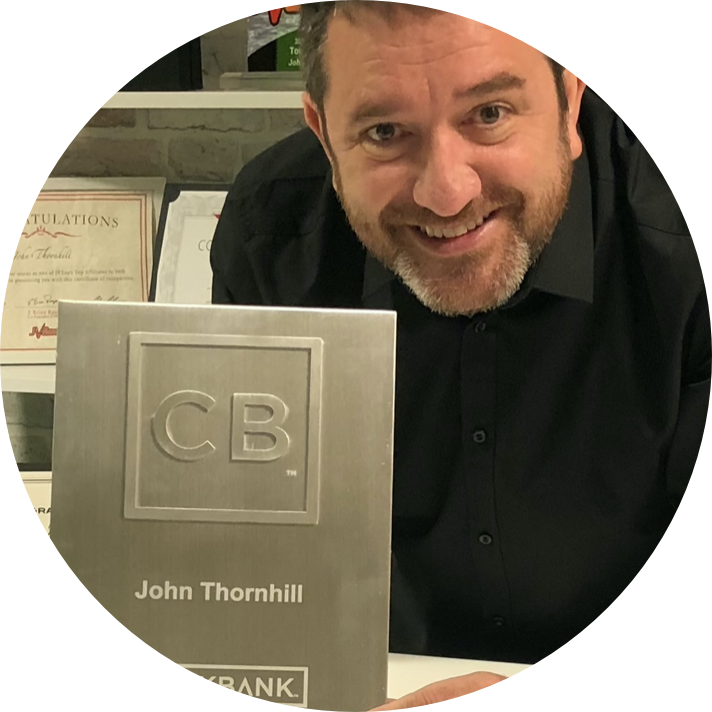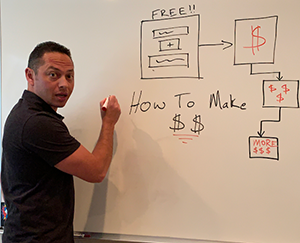Mastering Delegation: How to Transform Your Business and Life written by John Jantsch read more at Duct Tape Marketing
The Duct Tape Marketing Podcast with John Jantsch In this episode of the Duct Tape Marketing Podcast, I interviewed Dave Kerpen, a seasoned entrepreneur and New York Times bestselling author with a passion for effective leadership and delegation. Dave and I uncover the transformative power of delegation, shedding light on how mastering this skill can […]
The FUD Factor: How Fear, Uncertainty, and Doubt Shape Leadership written by John Jantsch read more at Duct Tape Marketing
The Duct Tape Marketing Podcast with John Jantsch
In this episode of the Duct Tape Marketing Podcast, I interviewed Brendan Keegan, a seasoned executive with over three decades of experience in leadership and innovation. Brendan is also the author of the book “The FUD Factor: Overcoming Fear, Uncertainty, and Doubt to Achieve the Impossible.” Our conversation covers the profound impact of fear, uncertainty, and doubt (FUD) on leadership and how mastering these emotions can shape the trajectory of businesses and individuals alike.
Key Takeaways
Questions I ask Brendan Keegan:
[02:11] Is there’s a personal story of how you overcame FUD?
[03:30] How does FUD show up in the workplace?
[05:00] What are some best practices to admitting fear and overcoming it?
[06:42] What inspired you to write a book about overcoming fear?
[07:39] Talk about fearless leadership
[10:55] What are some of the key traits that this fearless leader needs to learn or evolve in their arsenal?
[13:16] Would you say a high level of self-awareness is one of them?
[14:41] How does leadership act as a differentiator between good teams and great teams?
[17:32] Why does leadership matter more now than ever?
[19:56] Is there some place you’d invite people to connect with you, and learn more about the FUD Factor?
More About Brendan Keegan:
Like this show? Click on over and give us a review on iTunes, please!
Connect with John Jantsch on LinkedIn
This episode of The Duct Tape Marketing Podcast is brought to you by ActiveCampaign
Try ActiveCampaign free for 14 days with our special offer. Exclusive to new customers—upgrade and grow your business with ActiveCampaign today!
Speaker 1 (00:00): I was like, I found it. I found it. This is what I’ve been looking for. I can honestly say it has genuinely changed the way I run my business. It’s changed the results that I’m seeing. It’s changed my engagement with clients. It’s changed my engagement with the team. I couldn’t be happier. Honestly. It’s the best investment I ever made. What
John (00:17): You just heard was a testimonial from a recent graduate of the Duct Tape Marketing certification intensive program for fractional CMOs marketing agencies and consultants just like them. You could choose our system to move from vendor to trusted advisor, attract only ideal clients, and confidently present your strategies to build monthly recurring revenue. Visit DTM world slash scale to book your free advisory call and learn more. It’s time to transform your approach. Book your call today, DTM World slash scale.
John (01:04): Hello
John (01:04): And welcome to another episode of the Duct Tape Marketing Podcast. This is John Jantsch. My guest today is Brendan Keegan. With over three decades of experience, he’s known for his practical insights and passion for innovation. Brendan’s focus on leveraging technology to streamline operations has made him a trusted resource for businesses of all sizes. He’s also the author of a book we’re going to talk about today, the FUD Factor, overcoming Fear, uncertainty, and Doubt, to Achieve the Impossible. So Brendan, welcome to the show.
Brendan (01:36): Alright, welcome. Thanks so much. I’m excited to be here. And just talk a little bit about marketing and fud.
John (01:41): So with St. Patrick’s Day, I’m recording this in March with St. Patrick’s Day, not too far behind us. I’ve been watching a couple Irish movies and I’m got to tell you, Brendan Keegan sounds like a character from an Irish movie.
Brendan (01:52): Yeah, well, my middle name’s Patrick, so I got the a hundred percent factor going there.
John (01:59): Awesome. So one of the main premises of the book is this idea of fud, which I think is a term that I’ve heard used by other folks. Fear, uncertainty, and doubt is kind of learn throughout our lives. I’m curious if there’s a personal story of how you overcame your own brand of fud.
Brendan (02:18): Well, it’s interesting. As a kid, your parents kind of put FUD onto, but you don’t realize it until you’re a parent. So I remember when I started realizing it when our daughter was really small, but then when she started playing sports, and I still remember she had a skateboard, and all of a sudden it’s get the helmet on, get the knee pads, get the elbow pads on, and it’s like, Hey, in case you fall now to a 5-year-old, they don’t think they’re going to fall. So I put the idea of falling into her head and with all the equipment, all of a sudden she was thinking, Hey, I’m just going to go down the hill. I’m going to ride it over to my friend’s house, house’s going to have no issues. And all of a sudden I turned what was going to be a fun ride into a very dangerous sport that she had to be very careful of. The same could be said, going downhill, ski, and you get ’em bundled up, put the helmet on and everything. But as parents, we tend to be protective because we know they can fall, but we start to unintentionally with the best of intentions, impart some of our fear, uncertainty and doubt. Fear. What if they fall, they’re going to break their arm. Well, they didn’t plan on falling.
John (03:30): So how does that show up then in the adult version of the workplace?
Brendan (03:36): Well, as you grow up, it manifests where all of a sudden someone wants to play soccer, and it’s like, I’m not sure if I’m going to make the team. Well, do I try out? Do I not try out, who am I going to ask to prom? What if they say no? It’s like, well, what if they say yes? So we start just as human beings to put the doubt inside our own heads, whether it, well, I’m not going to try off this document, I’m not going to make it. Why? Well, I’m not good enough, as opposed to, Hey, if I practice, I’m good enough. And some of that just can be environmental. Did you grow up in a house where your family, your guardian, your uncle, your parents did say, Hey, if you practice 30 minutes a day, you’re going to make the team? Or did they reinforce the, Hey, it’s going to be really tough to make the team. I coached football for a number of years, not here. Parents say, I’m so concerned, I just know if he plays football, he’s going to get hurt. And I’d say, what if I told you there’s three times more injuries in cheerleading than there is football in youth sports, or if that matter, high school sports, but you don’t have a fear of your daughter or son cheerleading. But football has that, and so we’re just programmed.
John (04:47): So you talk about this, some examples of how you’ve worked with team members to push them on because people show up then at the workplace in their twenties, thirties, and forties, still with some of that residual doubt. So what are some of the ways that you’ve found practices, tactics, strategies, whatever you want to call ’em, to get people to move paths that to like, okay, I’m admitting I’m afraid. How do I move past sales?
Brendan (05:10): I think the first thing is talking about you are going to fail, just kind of saying, okay, it’s okay to fail. So on my wall at every office, I have the saying, have the courage to fail and the faith to succeed. So the first thing, best practice is make failure acceptable. So that’s automatically, you’re going to say, well, if this doesn’t succeed, I’m not going to lose my job. I’m not going to be in the penalty box. I’m not going to get in trouble. The next thing I’d say is when you do have failures in your company, don’t hide from ’em. Talk about ’em. So if you do zoom calls, say, Hey, this week we’re going to talk about one of our successes, but we’re going to talk about one of our failures. And when you talk about the failure, talk about what you learned and how you’re a better company because of the failure, because I’ve had lots of failures in my career going into new markets, and you really learn, wow, we thought we were going to do well in this market, and you really learned that you didn’t, by the way, sometimes when you’re successful, you don’t diagnose it as much as to you just kind of keep doing it.
(06:09): So I think the first best practice is let failure be acceptable, let failure be something that’s possible, and then just some very light training on how do you overcome fear. Some of that can be design thinking, some of it can be some innovation courses. And what’s great now is whether it’s LinkedIn learning or just all the free learning online, there’s courses where you can learn how to think and then test your ideas.
John (06:35): I probably should ask this first, but you’re, by all intent and purposes from your bio, you’re an operations guy. What inspired you to write a book about overcoming fear?
Brendan (06:47): I’ve had a chance to be a CEO for the last 23 years, and I’ve gone into six different companies, every one of ’em. We were trying to either do a turnaround or a transformation, so we were trying to go against our natural momentum. And what I found is I had to spend more time internally changing mindsets than externally. Externally, you could see here’s a great market, but internally I’d have people saying, oh, here’s why. Here’s, we’re not going to be successful in that market. We’ve never pursued that market. We’re not prepared for that market. And I’d scratch my head as an outsider, saying, why? And you start to get the, well, we haven’t done that before. And my favorite is, well, we tried that when? Five years ago. Five years ago for
John (07:29): One week, right?
Brendan (07:31): Or five years ago, you might not have had the capability to do it that you have today. And just things change.
John (07:37): You talk a lot in this book about something you call fearless leadership, and I’m curious if you could help to find that, because I mean, there’s certainly lots of fearless leaders that lead people off cliffs as well, so I’m guessing that’s not exactly the same sense in which you mean it.
Brendan (07:52): Yeah, no, in Fearless Leadership is about creating an environment that allows people to fail, allows people to try, allows people to take risks, and then allows those successes to be celebrated. So it’s not reckless leadership. I’m not a fan of, Hey, let’s just pursue any market for any reason. One thing I talk about oftentimes is establish some guardrails like, Hey, we can pursue any market as long as we make 5% margin. So you’re saying, okay, you can’t pursue something that we’re going to lose money or say, Hey, we’re going to start a business, and it’s okay if we lose money in the first year. It’s not okay if we lose money in the third year. Someone might say, well, to start the business, I can’t make it profitable the first month, but I can make it profitable after a year. What I find is set up some parameters, set up some guardrails and say, okay, this, as long as we’re within here, you can operate in any way you see fit.
(08:46): And that can be how fast do we want it to grow? What clients do we want to pursue? How profitable do we want it to be? What’s the time horizon? We’re going to do this for six months, and then we’re going to assess. So it’s not reckless, but it’s creating an environment, setting parameters, and then going after it in a way that you wouldn’t have gone after. Because if you go after it in a very calculated, slow manner, there’s a good chance that the opportunity passes you by. So you do have to go about it in a very intentional way.
John (09:20): It’s my pleasure to welcome a new sponsor to the podcast. Our friends at ActiveCampaign. ActiveCampaign helps small teams power big businesses with a must have platform for intelligent marketing automation. We’ve been using ActiveCampaign for years here at Duct Tape Marketing to power our subscription forms, email newsletters, and sales funnel drip campaigns. ActiveCampaign is that rare platform that’s affordable, easy to use, and capable of handling even the most complex marketing automation needs, and they make it easy to switch. They provide every new customer with one-on-one personal training and free migrations from your current marketing automation or email marketing provider. You can try ActiveCampaign for free for 14 days and there’s no credit card required. Just visit active campaign.com/duct tape. That’s right. Duct Tape Marketing podcast. Listeners who sign up via that link will also receive 15% off an annual plan if purchased by March 31st, 2024. That’s activecampaign.com/duct tape. Now, this offer is limited to new active campaign customers only. So what are you waiting for? Fuel your growth, boost revenue and save precious time by upgrading to active campaign today.
John (10:37): So leadership’s one of those things that it’s like sales people are either really good at it or they’re not, right? They, they’re like born salespeople. Same with leadership. I think a lot of people say, oh, that person’s born leader, some people suggest that it can be learned. I know that you fall on the, it can be learned, but what are some of the key traits that this fearless leader really needs to have or really needs to learn or evolve in their arsenal?
Brendan (11:05): So the first is when I look at the best leaders out there that are able to do fearless things that are able to transform businesses, the first thing that they have is they’re good communicators. That’s both in writing and in person in verbal communications, they’re able to articulate their ideas, they’re able to then influence people to follow them, meaning they come up with an idea, like during covid, we said, Hey, e-commerce and last mile is going to take off. More people are receiving things at home. I was running a commercial fleet company, so we said we should pursue that more. Okay, great. Then what you needed to do is then you needed to influence more people. So you needed to create a narrative and be able to communicate so you could influence people. The third thing is people that are good disruptors or transformers or innovative or fearless, tend to be good at relationships because they know I’m asking you to take a risk with me.
(12:01): So what’s our trust level? Do you believe in me? Do we have trust? If you have trust in me and I’m influencing you and I’m keeping you up to date and I’m communicating with you, you’re much more likely to come along with me as opposed to simply just follow. Now, some of the other things are, they’re also good project managers. They’ve got some good project management skills, not, Hey, we’re going to try this anyway. So they’re able to say, we’re going to do phase one, we’re going to do phase two, we’re going to do phase three. By the way, now they don’t individually have to have all these skills. They got to make sure the team
John (12:34): Has these skills. Yeah, I was going to say, I’m terrible at project management, but I have a great number too.
Brendan (12:39): But that’s where you’d read the communications. The next thing is you’d create the vision and then you might bring in somebody that says, okay, you’re going to work in Microsoft Excel or Microsoft Project. You’re going to run the project side of this. And so you don’t have to have the skill, but the team has to have that skill. And that last one I talked about is you have to be able to paint a higher vision of something extraordinary, something that is above the norm so that people can strive for that.
John (13:07): I interview, I’ve been doing this show for 15 years, and I’ve interviewed dozens, probably a hundred folks that have written books on leadership. I’ll tell you the one thing that always comes up when somebody’s talking about becoming a better leader is a pretty high level of self-awareness, like understanding yourself. I’m curious where you would put that one.
Brendan (13:29): Yeah, so I put that under the banner of eq, emotional intelligence. I know at one point in my career, I got told Brendan, you got all the IQ to do anything you want in this world, but if you don’t develop more eq, you’re going nowhere. And tough message to receive In my early twenties, and this is why I believe leadership can be learned, I really learned how to have more e and self-awareness. And oftentimes you get people who are working on a project, especially if it’s a fearless project or a disruptive project, where they get myopic tunnel vision, where it’s all about their project and they don’t realize, no, you’re in a bigger company. There’s a bigger thing going on. The resources you need might be necessary, might be pulled to work on another project. So I know that was something I wrestled with early in my career. It’s like if it was my project, I was like, I was going to run it up the hill. Even if I had to even run over a team member, I have to really learn. And that’s that influence part, and that’s that relationship part where as you ratchet up your eq, most of us have the IQ to do whatever we want. We really do. It’s the emotional intelligence that oftentimes pulls us back.
John (14:37): Kind of the read the room thing. Yeah, you go as far as saying, let me find it. Leadership is the single biggest differentiator between good teams and great teams and organizations. That’s putting a lot up. Some might suggest an outsized amount of impact over product, over marketing, over talent. Helpful. Fill in the blank there.
Brendan (14:58): Yeah. So many times when we look at great products or great companies, they weren’t the first to develop it. Oftentimes they were the second, they were the third. They were the ones though that were willing. They were the ones that were ready, willing and able to go try it. So whether this is video streaming, when Blockbuster had that ahead of Netflix, the digital camera, Kodak had that before the Instagrams, if you will, of the world. How about the Blackberry? The Blackberry had a jump on Apple and Samsung, and then Apple really kind of jumped in there. So when you diagnose a lot of that and you say what held some companies back and what throttled more companies forward? It was those leaders that were able to communicate influence, build a vision, build their relationships, and get their teams to climb the hill, as opposed to at companies that had superior products, the superior product was going to get you so far before somebody fundamentally came up with something that was as good or better. And how do you bring the entire company along? And we can look at the Apples, the Starbucks, the Netflix, the Amazons, the eBays companies that they really, Tesla, their cultures became so vital to their success.
John (16:19): You imagine that meeting an executive at Kodak walks in and says, look, five years from now, nobody’s going to be using film. We have Doug Bo all in on digital cameras. I mean, I’m guessing that probably happened somewhere, and they went, get out of here. We never want to hear from you again. Right?
Brendan (16:35): Well, at that point, a huge part of their profit came from the film, just similar to at one point the HP printer division. All their profit wasn’t from the printers, it was actually from the cartridges. Now, I’m sure some engineers said, Hey, I came up with a cartridge that uses a lot less sync, and they’re probably like, oh, no, that’s not what we want. But that’s where there’s a saying, cannibalize yourself or be cannibalized. If you’re not going to do it, somebody’s going to do it to you.
John (17:01): I use the example all the time. Newspapers wouldn’t give away free classified ads because it was such a profitable part of their business, and then Craigslist came along and all of a sudden they were hurting.
Brendan (17:13): Yeah. Okay, good.
John (17:15): So you talk about six key reasons why leadership matters more than ever today. So it feels like every new, I’ve owned my own business for 30 years, and it seems like every year X matters more than ever. X matters more than ever. Why does leadership matter more now than ever?
Brendan (17:35): Yeah. So right now we’re seeing the baby boomers start to age into retirement. And so if you just look at the generations, you’re seeing baby boomers now, by the way, baby boomers are living longer and working longer. So that’s helping. But literally, when you just look at just pure math demographics at the number of people retiring and the number of people entering the workforce, it suggests that there’s a void being created now as people are entering where the voids being created is in the leadership ranks, in that somebody that’s retiring with 35 years, 40 years experience, that experience has translated into some level of leadership. Now, leadership isn’t always a hierarchy leadership. They could be an individual contributor, but they’re leading an r and d project on a given product because of their experience and what they’ve done. So when you look at the first thing is the math.
(18:29): The second is that void that’s being created, we’re asking people to lead earlier than we ever have. So when I look at companies that I’ve run over the last five and six years, I’ve had people in their late twenties and thirties running significant parts of the business that 15 years ago they would’ve been in their late thirties, early forties. And some of that’s just, you look around and you say, Hey, this is the talent that’s available. Now, what I’ll also tell you is as you look at each generation works differently, thinks differently, learns differently. One thing that when we talk about diversity, going a little off topic, one thing I talk about in leadership that a lot of people don’t is have diversity of age on your leadership teams have somebody in their twenties, thirties, forties, fifties and sixties. And the best example I give is if you hand a 60-year-old, a Rubik’s Cube and a 15-year-old of Rubik’s Cube, they absolutely go about it. Totally different. The 60-year-old starts spinning it around. The 15-year-old goes to YouTube for someone to watch a video on how to do it. As you build leadership, I think it’s great. I think it’s an amazing opportunity to bring younger people into leadership. I think if people that are in their mid to late career are willing to sit in the room and learn from them, I think you’re going to be a more innovative, more disruptive, more transformative company. Yeah,
John (19:50): No question. I concur. So Brendan, I appreciate you taking a moment to stop by the Duct Tape Marketing Podcast. Is there someplace you’d invite people to learn about you, connect with you, and obviously find out more about the fund factor?
Brendan (20:03): Yeah, sure. So F Factor is available online at any of the bookstores, Amazon, Barnes and Noble. I’m on Instagram. That’s probably where I’m quite a bit on at BPK Brennan p Keegan Fearless. I have a LinkedIn newsletter, about 150,000 subscribers. It’s Fearless Leadership. You can hook me up on LinkedIn. I’ve got my email and my mobile phone right there. So if you want to reach out to me right there. And then I also have a website, brendan p keegan.com. If you’re looking to, you can get more information.
John (20:31): Awesome. Well, again, I appreciate you stopping by. Hopefully we’ll run into you one of these days out there on the road.
Sign up to receive email updates
Enter your name and email address below and I’ll send you periodic updates about the podcast.
Recommended Story For You :

How To Make $3493 Commissions Without Doing Any Selling

Successful dropshippers have reliable suppliers.

People Think I Use A Professional Voiceover Artist. NO! I Just Use Speechelo!

Make Money Testing Apps On Your Phone Or Tablet

Make More Money or Lose Everything

Sqribble Is The ONLY eBook Creator You’ll Ever Need.

Work & Earn as an Online Assistant

Create Ongoing Income Streams Of $500 To $1000 Or More Per Day

It's The Internet's Easiest Side Business.





